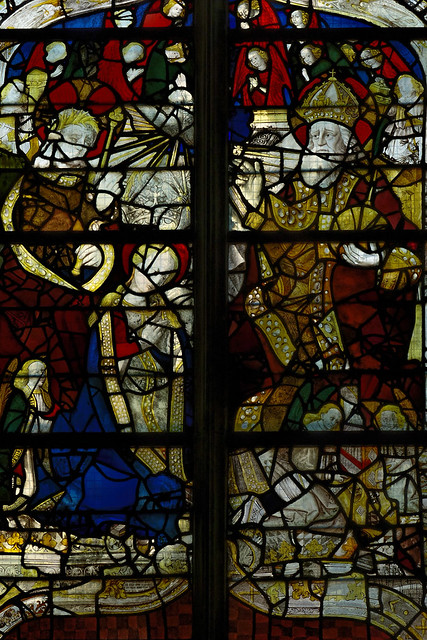Coronation and Death of the Virgin - Saint-Maclou, Rouen

This window (c1470), in the Church of Saint-Maclou, preserves fragments of a mid-15th-century Marian cycle, originally illustrating two principal episodes from the end of the Virgin’s earthly life: the Dormition (Death of the Virgin) in the lower register and the Coronation of the Virgin in heaven in the upper register. Although large sections of the original glazing have been lost, the surviving elements remain representative of the high-quality figure painting produced in Rouen around 1470.
Upper Register — Coronation of the Virgin

The upper portion contains heavily fragmentary remains of the Coronation scene:
-
Christ and the Virgin enthroned beneath a celestial canopy (only partial heads, haloes, and vestments survive).
-
Angels in adoration, some with musical instruments, arranged around the central throne.
-
Deep blues, ruby glass, and extensive use of yellow-silver stain attest to a sophisticated colour range typical of Rouen workshops of the period.
-
The surviving fragments suggest an originally symmetrical composition, framed by a seated Christ crowning the Virgin, with attendant angels forming a mandorla-like surround.
Lower Register — Death of the Virgin (Dormition)

The Dormition scene is the most legible surviving element:
-
The Virgin Mary lies on her bier, dressed in a deep blue mantle, her head gently inclined.
-
A dense group of apostles gather around the bed. Several retain expressive faces and haloes characteristic of mid-15th-century Norman work.
-
Apostles on the left hold or support Mary’s hand; those on the right lean inward in prayerful devotion.
-
The remains of architecturalcanopy work above the scene indicate that this panel originally occupied a central position in the aisle glazing programme.
Despite its fragmentary state, the arrangement of the apostles and Mary’s bier clearly follows the established iconographic model for the Dormition in Normandy and Picardy.
Style and Attribution
The fragments show the hallmarks of Rouen painting c.1470:
-
soft modelling of faces with pale flesh tones
-
crisp linear work in the drapery
-
saturated blues contrasted with warm ruby glass
-
finely executed yellow-silver stain for orphreys, nimbuses, and canopy detailing
These features place the work within the orbit of the Rouen School, possibly linked to workshops active at Saint-Godard or the atelier responsible for glazing in the chevet of Saint-Maclou.
Condition and Reassembly
The window survives only in fragments, with the present configuration resulting from at least two major restoration phases:
-
Post-medieval salvage, which mixed surviving Marian scenes with unrelated quarries and decorative glass.
-
19th–20th-century reconstruction, producing the dense mosaic-like structure around the central scenes, characterised by extensive leadwork, irregular infill, and re-used medieval pieces.
The result is a hybrid composition, in which the original narrative survives only in the central zones, surrounded by modern and early-modern patchwork glass.
Provenance
The surviving panels are believed to originate from a Marian window located originally in the south aisle of the nave at Saint-Maclou. Archival sources suggest that the window suffered losses during both the Wars of Religion and later structural campaigns, leading to extensive reassembly.
